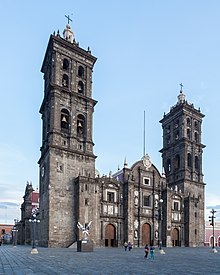This article needs additional citations for verification. (May 2022) |
| Cathedral Basilica of Puebla | |
|---|---|
Basílica Catedral Metropolitana de Nuestra Señora de la Purísima Concepción | |
 Puebla Cathedral | |
| Religion | |
| Affiliation | Roman Catholic |
| District | Archdiocese of Puebla de los Ángeles |
| Ecclesiastical or organizational status | Cathedral and Minor basilica |
| Year consecrated | 18 April 1649 |
| Location | |
| Location | Puebla de Zaragoza, Mexico |
| Geographic coordinates | 19°02′34″N 98°11′54″W / 19.04278°N 98.19833°W |
| Architecture | |
| Architect(s) | Francisco Becerra and Juan Gómez de Trasmonte (cathedral) Manuel Tolsá (cypress) Pedro García Ferrer (Altar of the Kings) Cristóbal de Villalpando (frescoes) |
| Style | Herrerian style (mainly), Neoclassical, Baroque |
| Groundbreaking | 18 November 1575 |
| Completed | (South tower) 1737 |
| Specifications | |
| Direction of façade | West-Orient |
| Length | 97.67 m (320 ft) |
| Width | 51 m (170 ft) |
| Width (nave) | 82 m (270 ft) |
| Spire(s) | 2 |
| Spire height | 70 m (230 ft) |
| Official name | Part of the Historic Centre of Puebla |
| Type | Cultural |
| Criteria | ii, iv |
| Designated | 1987 (11th session) |
| Reference no. | 416 |
| Region | Latin America and the Caribbean |
The Basilica Cathedral of Puebla, as the Cathedral of Our Lady of the Immaculate Conception is known according to its Marian invocation, is the episcopal see of the Archdiocese of Puebla de los Ángeles (Mexico). It is one of the most important buildings in the historic center of Puebla declared a World Heritage Site by UNESCO. It has the prerogative of being the first sumptuous temple that under fine architectural designs was built in the Americas, consecrated in 1649, ahead of the Metropolitan of Mexico that was dedicated in 1653. It was founded by Philip II of Spain.[1]
The current Herrerian-style cathedral was built between the 16th and 17th centuries, and replaced the previous one that existed in what is now the atrium. Seventy-four years passed from the beginning of its construction in 1575 to its consecration, during the reigns of three successive kings of Spain, Philip II, Philip III and Philip IV. The setbacks that occurred throughout those years led to numerous modifications of the original layout. By 1624 the works were completely suspended until the arrival of Bishop Juan de Palafox y Mendoza in July 1640, who resumed the works with determined enthusiasm. The new reforms gave a higher elevation to the central nave above the processional ones, allowing the passage of natural light and giving it the appearance of a pyramidal structure. It was consecrated by Bishop Juan de Palafox y Mendoza on April 18, 1649, without having been completely finished.
The space it occupies is rectangular in shape, recharged in the corner of another larger floor, forming a large space for the atrium. The building is organized into five naves: a central one, two lateral ones and two niche chapels, its Renaissance-style façade stands out. Attached to its back is a building for offices of the Mitra, its former headquarters, and the building of the chapel called Ochavo. With its little more than 70 meters high, it was the tallest church in the Spanish colonies.
The cathedral is considered one of the most important museums of New Spanish and later art due to the treasures it houses. Over the centuries it has been enriched in works of painting,[2] sculpture, goldsmithing and carpentry of great artistic quality, as well as its decorations, the large boarded doors, aluminum and the treasures of the sacristy that protect the rich priestly ornaments embroidered with gold and silver thread, sacred vessels, chalices, ciboria, reliquaries and crosses bathed in gold inlaid with jewels and diamonds. Its historical archive has documents dating back to the founding of the city and many are waiting to be classified.
- ^ Crowe, Gretchen R. (2006-12-14). "City of Puebla Shines as Mexican 'Jewel'". Catholic Herald. Retrieved 2010-12-02.
- ^ VI Encuentro Internacional de investigadores de la Red Latinoamericana de Cooperación Universitaria - Puebla Patrimonial: Los Tesoros Pictóricos de La Catedral (PDF). Puebla: University of the Americas. 30 October 2009. Archived from the original (PDF) on 2011-08-16.